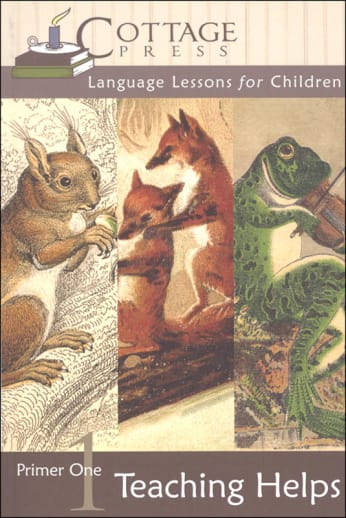The Teaching Helps book is used for all three Primer books in a series and includes instructions as well as information for the nature study plus tips on teaching grammar and spelling and answer keys (when applicable). There is one book to accompany the three books of the Primer 1 series. In addition to specific teacher notes for each of the daily lessons, there are introductory sections on general pedagogy and practice, weekly routine, and optional enrichment ideas. You'll want to spend a little time going over this and becoming familiar with the general instructional methodology, but daily prep is all done for you and the daily teaching notes coupled with the student books are very user-friendly.104 pgs. paperback.
Cottage Press Language Lessons for Children: Primer One Teaching Helps
Description
Gentle language lessons for early elementary students. Weekly routine includes copybook, narration from accompanying literature, grammar and spelling lessons based on copybook model, nature study, and picture study. Primer One spelling and grammar lessons reinforce spelling rules, introduce basic sentence skills, practice correct word usage with homonyms, antonyms, and synonyms, teach basic letter-writing, and develop rhyming skills.
Primer One Teaching Helps accompanies Primer One Autumn, Primer One Winter, Primer One Spring - covers all three books in one handy reference. Provides detailed instructions for conducting Copybook, Narration, Grammar & Spelling, Nature Study, and Picture Study lessons, notes and teacher tips for weekly lessons, and an Answer Key for exercises which warrant it.
Before beginning Primer One, a student should have achieved beginning spelling and phonics proficiency, be ready for beginning chapter books, and be able to copy words and sentences. Primer One is very generally appropriate for 2nd - 3rd grade students but could be used very effectively by older students as well.
- Accompanies Primer One Autumn, Primer One Winter, and Primer One Spring
- Detailed instructions for conducting Copybook, Narration, Grammar & Spelling, Nature Study, and Picture Study lessons
- Notes and teacher tips for weekly lessons
- Answer Key for exercises which warrant it
The Language Lessons for Children Primer One series provides grammar and spelling lessons, examination of basic sentence skills, word usage practice (particularly antonyms, synonyms, and homonyms) and word rhyming. Skills are taught sequentially, following the seasons. Before starting the Primer One series, the student should have some beginning spelling and phonics skills, be able to read simple words comfortably, and be able to copy basic words and sentences (i.e. 2nd/3rd grades). Additional resources include: Aesop’s for Children (Autumn), Fifty Famous Stories Retold (Winter), and The Adventures of Danny Meadow Mouse (Spring).
| Product Format: | Paperback |
|---|---|
| Grades: | 1-4 |
| Brand: | Cottage Press |
| Author: | Kathy Weitz |
| ISBN: | 9781494860226 |
| Length in Inches: | 9 |
| Width in Inches: | 6 |
| Height in Inches: | 0.3125 |
| Weight in Pounds: | 0.35 |

